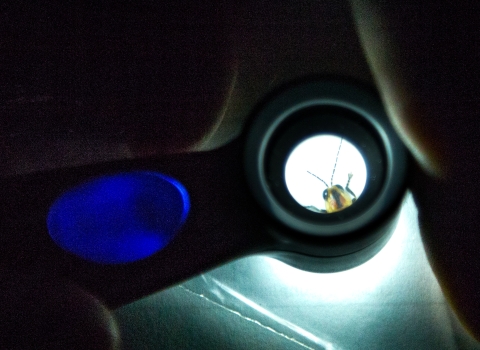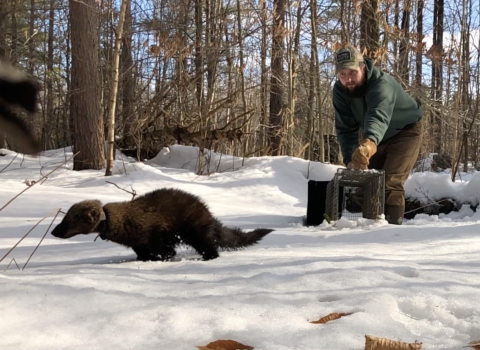By Jan Peterson, for the U.S. Fish and Wildlife Service
Helping critters in need seems instinctual for humans. But the next time you come across a bird you think might need help, rehabilitation experts ask you pick up the phone before picking up the bird.
The reasons for this are many, beginning with what’s best for the bird and including the Migratory Bird Treaty Act of 1918. This 105-year-old law, (rooted in separate treaties between the United States, Canada, Mexico, Japan and Russia) prohibits just about any human interaction with protected migratory birds unless permitted to do so by the U.S. Fish and Wildlife Service. It prohibits killing, capturing, selling, trading or transporting protected species, and there are more than 1,000 of them.
Leslie Westerlund is an internationally recognized expert in this area. Westerlund, who worked as a permitted rehabilitator before joining the Service as a contractor in 2012, is the Pacific Northwest region’s possession permit biologist. They handle every migratory bird rehabilitation permit in Washington, Oregon, Idaho and the Pacific Islands.
Westerlund explains the treaty came about under President Woodrow Wilson. He recognized unregulated bird hunting was having a calamitous effect on the winged animals. “They were killing birds willy nilly. They had already decimated passenger pigeons by over hunting and wiped out egret colonies to put feathers on hats,” they say.
So now, migratory birds – most of our native species – are protected, and some species have additional protections such as bald and golden eagles and threatened and endangered birds. Migratory bird rehabilitation facilities are required to have federal and state permits that allow them to accept, rear or treat any bird included in the treaty.
So what’s an ordinary person who knows absolutely nothing about regulations or animal care supposed to do if they stumble upon a downed or injured bird?
“In a perfect world, the person who finds an injured bird can call us and do nothing,” says Kit Lacy, bird curator at the Cascades Raptor Center, in Eugene, Oregon. “There are certainly situations in spring when animals are ‘rescued’ when they don’t need to be."
Jennifer Jill Rockwell – director of the Ruth Melichar Bird Center, in Boise, Idaho – explains “there’s a common situation of babies falling out of nests. Someone can send pictures from their cell phones and we can ask questions like, ‘Are their parents around?’ Maybe we can do a makeshift nest. There are a lot of options to keep it with its family.”
Rockwell says falling out of a nest is essentially a rite of passage for growing birds. “Many birds, when they outgrow the nest, they’re not a baby anymore. Think of them like a toddler. Sometimes they’re on the ground fluttering around while the family group is above encouraging them and teaching them how to fly,” she says.
But there are times when birds do need our help. After calling your nearest rehab center, follow their instructions on what to do next. You may be asked to leave the bird where you found it, but don’t be surprised if they ask you to safely pick up the bird and transport it to the nearest center. Rehab centers are run by experienced, permitted professionals, aided by volunteers and funded by donations. It can be difficult to find the staff to retrieve injured or ill animals.
Unfortunate interactions behind most injuries
Linda Elliott, president and director of the Hawaiʻi Wildlife Center in Kapaʻau, says that while humans are the ones rushing in to help birds in distress, it is important to note that human activities are also largely the cause of those injuries and illnesses in the first place.
“It is mainly human caused, whether it be impact injuries from getting hit by cars or running into buildings,” Elliott says. “Our (state’s) biggest problem is light pollution. Seabirds fledge for the first time at night and guide themselves out to sea by the light of the moon. Places like Oahu with lots of light pollution will attract hundreds.”
Lacy says nearly every bird her organization sees has had some sort of unfortunate interaction with humans.
“Oftentimes, we are seeing vehicle strikes, but also just individual animals nesting in close proximity to humans. It’s sometimes just a loss of appropriate nesting or places to raise their young,” Lacy says. “We’ll get orphans in because they’re in a dangerous place, but that dangerous place was the only place the adults could find. Sometimes, they’re injured in window strikes or ‘played’ with by well-intentioned but ill-informed humans who let their cats outside.”
Lacy says the numbers of deaths and injuries caused by domestic cats is shocking. A study conducted by the Smithsonian Conservation Biology Institute found that domestic cats alone kill between 1.3 billion and 4 billion birds and 6.3 billion and 22.3 billion small mammals annually in the 48 contiguous states. Worldwide, the Service says domestic cats have contributed to the extinction of 33 species.
Another common condition is caused by unintentional poisoning. When raptors consume poisoned mice and rats, they too are poisoned.
Returning birds to the wild is the goal
Rehabilitation is just that: rehab. “The primary focus is to return an animal to physical fitness and emotional fitness – it recognizes its own species, exhibits appropriate behaviors, is mechanically sound so it can survive in the wild,” Westerlund says.
Lacy says the first order of business when a bird is brought in is to stabilize the animal. “Shock can be a killer,” she says. The birds are hydrated and given vitamin B to help stabilize them. They’re then evaluated for any critical issues like bleeding and allowed to rest. “Finders often mistake shock for calm: ‘It knows I’m helping it.’ I’m going to give you some hard truth. It is just in shock.”
Once the bird is thoroughly examined, tough decisions are sometimes necessary. “Raptors are high-level avian predators. It’s already really difficult to be a predator in the wild,” Lacy says. “It needs to be fully functional in ability to fly, in their use of their feet which they use to grab prey … basically, we’re looking for a return to full function.”
Elliott says birds can be more challenging than other animals to treat. “I think birds are unique in that they don’t show when they’re sick very easily. They’ll be aggressive or feign alertness even in their last moments. They’re a challenge to diagnose and more sensitive than mammals to illness or injury. We have a smaller window of opportunity with them than with mammals,” she says.
Rockwell points out Mother Nature is vicious to begin with – 80% of nestlings won’t see their first winter. “When you come into a wildlife rehabilitation center, you may be buying more time, but you’re also being raised by humans. That’s really a little bit of a setback because we are not the biological parents of that baby and we can’t teach it what they need to know,” she says.
Some risks include the bird imprinting on a human or becoming habituated to being fed by humans. Rehabbers go to extraordinary lengths to prevent this from happening. They may conceal themselves in sheets or make masks out of cardboard boxes or simply cover the bird’s eyes during mealtimes.
“Sometimes, you’ll get a habituated bird, but you won’t typically get true imprinting,” Rockwell says.
“If it has time with like birds, it will unhabituate itself and break the mold. DNA takes over and their sense of being a bird returns,” she says.
If full rehabilitation isn’t possible, compassionate euthanasia is likely. “If an animal coming out of the wild can never fly again, that decision is pretty easy to make,” Lacy says. “We have the ability to end an animal’s suffering.”
“Euthanasia may be the final gift we can provide,” Westerlund says.
In rare instances, a recovering bird may be kept on as an ambassador for educational purposes or even a foster parent. Lacy’s center has a pair of barn owls that have fostered babies for more than a decade. “Our foster parents take great care of them. The foster parents can be busy from February through October in their care,” Lacy says.
But for all rehabilitators, the goal is to return the animal to the wild so it can maintain its role in the ecosystem and keep its species population as healthy as possible.
Each of the rehab experts stresses this isn’t something just anyone can do. It takes tremendous amounts of training, endless fundraising efforts, mountains of paperwork and enduring frequent heartbreak.
But each of them says they can’t imagine doing anything else.
“I think this is the most unique job anyone could have,” Rockwell says. “It’s a really rewarding job when you get this bird to a really stable state and you get to watch this bird fly off into the world. It just warms your heart.”
How you can help
- If you find a grounded bird, call your nearest rehabilitation center. They can ask a series of questions that will help determine whether the bird should be left in the wild, perhaps moved to a higher spot or nest or be taken in for treatment. The National Wildlife Rehabilitators Association’s website has resources to help you locate rehabbers in each state, or you can call your state’s department of natural resources or wildlife department for guidance.
- Keep your pets inside. A study conducted by the Smithsonian Conservation Biology Institute and U.S. Fish and Wildlife Service found that domestic cats alone kill between 1.3 billion and 4 billion birds and 6.3 billion and 22.3 billion small mammals annually in the 48 contiguous states. Worldwide, the Service says domestic cats have contributed to the extinction of 33 species. Kitties that stay inside live longer too. You’ll have more time to love them.
- Don’t use rat poison. It contaminates the food chain and leads to countless raptor poisonings each year.
- Roll up your sleeves! Rehabilitation facilities rely on volunteers to get through each day. People are needed for so much more than treating and feeding animals – everything from cleaning the facilities to answering phones. A few hours a week can make a difference.







